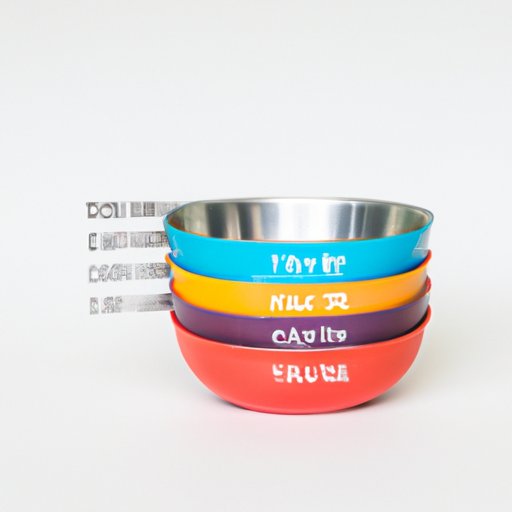I. Introduction
Have you ever found yourself in the kitchen with your recipe book in hand, only to discover that the measurement for your flour or sugar is given in grams instead of cups? Many people struggle with this conversion, and some may even resort to guessing or approximating. However, it is crucial to measure ingredients accurately in baking and cooking to get the best results. This article will provide you with a comprehensive guide to converting 500 grams to cups for different ingredients, complete with a conversion chart, recipe-based guide, infographic, and a comparison between regional measurement differences.
II. Explaining the Conversion
Grams and cups are both units of measurement commonly used in the kitchen. However, they are not interchangeable, and it is essential to know how to convert between the two accurately. Grams are a metric unit of mass, while cups are a unit of volume. This means that the exact conversion between grams and cups will depend on the density of the ingredient being measured.
For example, one cup of flour may weigh less than one cup of sugar due to the differences in density. Measuring ingredients by weight (in grams) is often more accurate than measuring by volume (in cups), and many professional bakers and chefs prefer to use a kitchen scale for precise measurements.
However, if you don’t have a kitchen scale and need to convert 500g to cups, here is a step-by-step guide:
- Determine the conversion factor for the ingredient you are measuring. This factor can vary depending on the density of the ingredient. For example, one cup of all-purpose flour weighs approximately 120 grams, while one cup of granulated sugar weighs approximately 200 grams.
- Divide the weight in grams by the conversion factor to get the number of cups needed. For example, if you are measuring 500 grams of all-purpose flour, divide 500 by 120 to get approximately 4.17 cups.
III. Recipe-Based Guide
Here is a list of popular ingredients that come in a 500-gram measurement, along with their corresponding cups:
| Ingredient | 500g | Cups |
|---|---|---|
| Flour | 500g | 4.17 cups (approximate) |
| Sugar | 500g | 2.5 cups (approximate) |
| Water/Milk | 500g | 2.11 cups (approximate) |
It is essential to note that these conversions are approximate and can vary depending on factors such as the brand and type of ingredient, as well as how it is packed and measured.
Below are some examples of recipes where conversion may be needed:
- Pizza Dough – This recipe requires 500g of all-purpose flour, which is equivalent to approximately 4.17 cups.
- Shortbread Cookies – This recipe calls for 500g of granulated sugar, which is equivalent to approximately 2.5 cups.
- Custard – This recipe requires 500g of milk, which is equivalent to approximately 2.11 cups.
IV. Conversion Chart
A conversion chart can be a handy tool to have in the kitchen for quick and easy reference when converting between grams and cups. Here is a comprehensive tabular representation of conversion for popular ingredients:
| Ingredient | Grams | Cups |
|---|---|---|
| All-Purpose Flour | 120g | 1 cup (approximately) |
| Brown Sugar | 220g | 1 cup (approximately) |
| Granulated Sugar | 200g | 1 cup (approximately) |
| Butter | 227g | 1 cup (approximately) |
| Milk | 240g | 1 cup (approximately) |
Using this chart is simple. Identify the ingredient you are measuring, and then use the grams-to-cups conversion given. For example, if you need to measure 500 grams of brown sugar, you can see on the chart that it is equivalent to approximately 2.27 cups.
The advantages of using a conversion chart are that you can quickly and easily reference it without having to perform any calculations. However, it is essential to keep in mind that these conversions are approximate and can vary depending on the factors mentioned earlier.
V. Infographic
If you are a visual learner, an infographic can be an excellent option for easier understanding of the conversion process. This visual representation can include illustrations, diagrams, or flowcharts, making it easier to follow the conversion process. Here is an example of an infographic for converting 500 grams to cups:

The advantages of using an infographic are that it can be easier to understand the conversion process, especially for those who are more visually inclined. It can also be a handy visual reference to have in the kitchen.
VI. Comparison Article
Regional differences in measurements can be a significant point of confusion for those learning to cook or bake. Different countries may use different units of measurement, making it challenging to follow a recipe from another country. For example, in the United States, ingredients are often measured in cups, ounces, or teaspoons, while in Europe, grams and milliliters are more commonly used.
Here is a guide to converting between different units of measurement:
- 1 cup = 236.6 milliliters
- 1 fluid ounce = 29.57 milliliters
- 1 tablespoon = 14.8 milliliters
- 1 teaspoon = 4.93 milliliters
- 1 gram = 0.035 ounces
It is essential to note that these conversions are approximate and can vary slightly depending on factors such as the brand and type of ingredient.
VII. Conclusion
In conclusion, measuring ingredients accurately is crucial for getting the best results in cooking and baking. Converting between grams and cups can be challenging, but with the comprehensive guide provided in this article, you can feel more confident about your measurements. Remember to use the recipe-based guide, conversion chart, infographic, and comparison article to find the most accurate measurement.
Knowing how to measure ingredients correctly can make a big difference in the quality of your finished dish.
